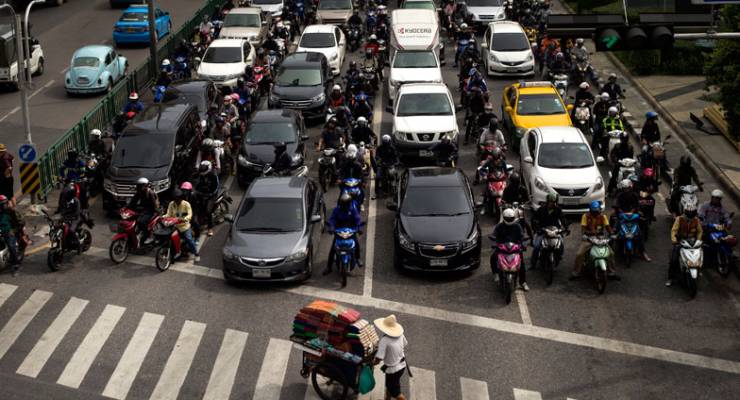
Last week’s brutal bashing of an elderly British couple and their son highlighted the ever increasing dangers of traveling to Thailand. But among the bashings, murders and strings of mysterious suicides, as more than 900,000 Australians continue to flock to Thailand every year (according to DFAT figures), many don’t realise that the most likely way they could die in the self-styled “land of smiles” is in a motor vehicle accident.
During the seven days of the New Year’s Songkran festival (April 11-17) — Thailand’s equivalent to Christmas and New Year, when countless numbers of people desert Bangkok and other urban regions and return home to spend time with their families and pay homage at local temples — 442 people died on the country’s roads. This was up 21% on the year before, despite a government road safety campaign. There were 3447 road crashes, from which 3656 people were admitted to hospital for treatment of serious injuries.
It’s a shocking statistic underscored by the fact that Thailand has the second-highest per capita road death toll in the world. There are 44 deaths per 100,000 people (or a truly scary 5.1% of Thailand’s overall deaths), according to statistics from the World Health Organization and The University of Michigan Transportation Research Institute in the United States.
On paper, Thailand’s road infrastructure is much better than that of neighbours like Cambodia, Indonesia and Myanmar. So why is its road toll so much higher?
Alcohol is one reason. Drink-driving remained the biggest single cause of road crashes during Songkran this year and was blamed for 34% of deaths, followed by speeding at 33%. There is a deeply ingrained drinking culture in the country (so much for the Buddhist abstinence), yet there is little systematic random breath testing, and the police force, woefully underpaid at an officer level, remains highly susceptible to taking cash in lieu of actually charging people with offences.
Vehicle type is another factor: 80% of deaths during Songkran alone involved the country’s ubiquitous moped and motorbikes, where helmet wearing appears to be random. Even if helmets are worn they are often perfunctory.
And this, particularly, is where the danger to tourists comes in as they hire bikes to ride, blissfully unaware of the death trap that Thailand’s roads are. The statistics in bike injuries around tourist haunts like the islands and northern mountain backpacker hangouts like Pai are ugly.
There is also a healthy market, locals say, in driver’s licences. Like most things in the developing world, they can be bought without going anywhere near a driving test.
But it’s when one hits the open road in provincial Thailand that the problems rapidly become clear.
I have driven in dozens of countries around the globe — admittedly, mainly in the developed world — but I do not recall ever being so terrified, and quite seriously concerned for myself as well as my four travelling companions, as I was on a road trip from Bangkok to Chiang Mai in the country’s north in the days leading up to the 2015 New Year.
The drive to our first port of call near Sukhothai, one of a cluster of ancient Siamese capitals in the middle of the country, was on the main freeway and reasonably uneventful. As we moved on for the second leg to Chiang Mai, taking an incredibly scenic route across the mountains, a reasonably traffic- and hassle-free drive quickly turned into something of a nightmare as we merged with one of the major highways, just in time to make the descent to the plain.
As a queue of four or five cars approached a blind bend, suddenly one would pull out — not indicating, never indicating — and overtake the lot driving on the wrong side of the road into a blind corner. If an oncoming car came there was no way out for anyone. And it happened again and again.
At Chiang Mai, two of our party split off, including the only other driver. As the road toll mounted into the hundreds, the fresh numbers on the front of each day’s Bangkok Post, I became increasingly nervous about the drive back: an eight- to nine-hour slog we had opted to break up at a friend’s guesthouse halfway back.
But taking highway 1, an almost entirely dual carriageway arterial between Thailand’s two biggest cities that loops around the mountains, seemed like a safe bet.
Not so. In a country where the speed limit is 100km/h most cars — and trucks — were sitting on about 130km/h. Only a handful of cars on the entire trip indicated. Cars would pull out in front of you with less than half a metre to spare. It was like being in a video game.
On January 2 and 3, prime time for holiday traffic, we did not spot one single speed patrol nor see a single police car stopping any driver.
Since the military junta seized power in Thailand almost two years ago, there has been a step-up in the public commentary about all manner of “bad behaviour” in the very paternalistic way in which the junta conducts public discourse.
At least the road toll has been among the things the generals are constantly admonishing their subjects about. Yet the commentary from the government has been very much focused on drink drinking, which while certainly a part of the problem, is hardly being addressed in a systematic way.
There were some encouraging headlines recently that people caught drink drinking would be made to do community work in morgues. But, like much in Thailand, it was probably just that: a headline, because any efforts being made, the recent Songkran road roll tells us, are not working.
More fundamentally, Thailand has yet to really bite the bullet on the overriding problem of driver education: simple stuff like keeping to speed limits, wearing seat belts, indicating and good old-fashioned careful driving.
Sure, reincarnation might be around the that blind corner, but that’s no reason to take other people with you.








Began my love affair with South East Asia as a surfer back in 74 to 76 with visits to Bali. I had my motorbike licence but still had to pay the 35k rupiah but so did many of the non licenced Aussies who came with some horrific injuries from burns from the exhaust to full body skin rashes from crashes in thongs and board shorts.
I’ve seen some horrible carnage in all SE Asian countries but especially Thailand and Vietnam. Only place I’ve ever driven is Langkawi the island paradise which has roads way better than Northern Victoria where I live.
In short Aussies don’t drive OS. Most people are rotten drivers including us.
To be fair, non-use of indicators seems on par (norm, get it?) with my home town of Newcastle NSW, first-world Australia.